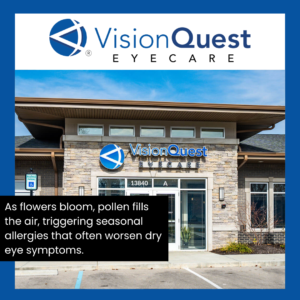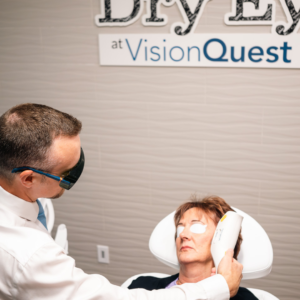If you suffer from dry, irritated eyes, you may have noticed that your symptoms change throughout the year. Seasonal shifts bring different environmental challenges, from winter’s dry air to spring’s pollen overload. For those with dry eye syndrome, understanding how weather affects tear production and eye hydration is essential for maintaining comfort year-round.
While eye drops and at-home remedies can provide temporary relief, addressing the underlying cause of dry eye is key to long-term improvement. In this guide, we’ll explore how each season impacts eye health and what you can do to protect your vision in any weather.
Winter: Dry Indoor Air and Harsh Winds
Cold winter air lacks humidity, which can cause tears to evaporate quickly. Indoor heating systems worsen the issue by further reducing moisture levels, leading to increased eye dryness. Windy conditions outside can make symptoms even more pronounced. Many people experience burning, redness, and a sensation of grittiness, and some even experience excessive tearing as the eyes try to compensate for dryness.
To combat winter dry eye, consider using a humidifier to add moisture to indoor air. Wearing protective eyewear when outdoors can shield your eyes from harsh winds, while taking breaks from screens can reduce digital eye strain.
Spring: Pollen and Allergies
As flowers bloom, pollen fills the air, triggering seasonal allergies that often worsen dry eye symptoms. The body’s natural response to allergens includes inflammation, itching, and excessive tearing, which can disrupt the tear film and leave eyes feeling even drier.
Minimizing outdoor exposure on high-pollen days and washing your face and hands frequently can help reduce irritation. Using lubricating eye drops may also provide relief, but if symptoms persist, a professional dry eye evaluation may be necessary to address underlying inflammation.
Summer: Sun Exposure and Dehydration
Hot temperatures and prolonged exposure to sunlight can exacerbate dry eye symptoms. UV rays contribute to eye irritation, and dehydration from high temperatures can reduce tear production. Those who spend time swimming in pools or the ocean may also notice an increase in dryness, as chlorine and salt water can strip away the eye’s natural tear film.
Staying hydrated is essential in summer, as is wearing sunglasses with 100% UV protection to shield the eyes from sun damage. If swimming causes discomfort, using preservative-free artificial tears before and after water exposure can help maintain moisture.
Fall: Windy Days and Seasonal Changes
As temperatures drop, the combination of cooler air and seasonal wind gusts can make dry eye symptoms flare up. Fall also brings an increase in colds and flu, which can lead to eye irritation and a higher likelihood of rubbing the eyes—a habit that worsens dryness and inflammation.
Using artificial tears regularly can help maintain hydration, and applying a warm compress may soothe irritation. Maintaining good hand hygiene can also reduce the risk of eye infections, which can further aggravate dry eye symptoms.
Advanced Dry Eye Treatment for Long-Term Relief
For those who struggle with persistent dry eye symptoms year-round, professional treatment may provide the relief that at-home remedies cannot. While artificial tears and humidifiers can help manage symptoms, they do not address the underlying causes of dry eye, such as meibomian gland dysfunction (MGD) or chronic inflammation.
At VisionQuest Eyecare, OptiLight IPL therapy and OptiPLUS RF treatment are used to restore healthy tear production and improve overall eye comfort. OptiLight IPL targets inflammation, helping the oil glands in the eyelids function properly, while OptiPLUS RF uses radiofrequency technology to hydrate the eyes and reduce discomfort. As an added benefit, OptiPLUS RF also helps tighten the skin around the eyes, offering a refreshed appearance.
If seasonal dry eye symptoms are disrupting your daily life, a comprehensive evaluation can determine the best course of treatment for long-term relief. Schedule an appointment today to learn more about advanced dry eye solutions and take the first step toward healthier, more comfortable vision.

Dr. Collin Rush is passionate about bringing clear eyesight and better eye health to the community. Having graduated in the top 1% of his class at Indiana University School of Optometry, Dr. Rush primarily focuses on dry eye and keratoconus but is also trained in laser therapies for glaucoma and secondary cataracts.



